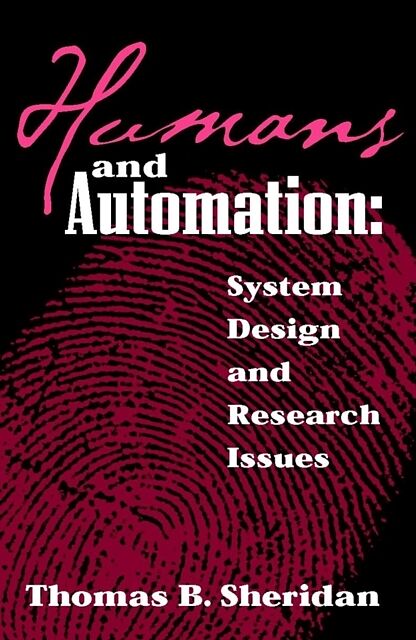Humans and Automation
Einband:
Fester Einband
EAN:
9780471234289
Untertitel:
System Design and Research Issues
Genre:
Informatik
Autor:
Thomas B Sheridan
Herausgeber:
Wiley
Anzahl Seiten:
280
Erscheinungsdatum:
11.07.2002
ISBN:
978-0-471-23428-9
Informationen zum Autor Professor Sheridan has an unusual professional background, combining both engineering and psychology. His research has relevance to many fields, especially aviation and space. He has academic appointments in both the Department of Mechanical Engineering and the Department of Aeronautics and Astronautics. In both departments, he is listed as a professor of engineering and applied psychology, a title that reflects the intersection of technological and human issues involved in his work. He also participates in projects at the Center for Transportation Studies and the Research Laboratory of Electronics. His research has included human-computer interaction in aircraft and space piloting; high-speed trains and "smart" highway systems; undersea and industrial robotic systems; and computer-graphic displays and decision aids. He has taught many undergraduate and graduate subjects, ranging from the basic mechanics of solids to models of man-machine systems. Professor Sheridan received the ScD degree from MIT in 1959 in the field of human-machine systems. Klappentext Human factors! also known as human engineering or human factors engineering! is the application of behavioral and biological sciences to the design of machines and human-machine systems. Automation refers to the mechanization and integration of the sensing of environmental variables! data processing and decision making and mechanical action. This book deals with all the issues involved in human-automation systems from design to control and performance of both humans and machines. Zusammenfassung Human factors! also known as human engineering is the application of behavioral and biological sciences to the design of machines and human machine systems. Automation refers to the mechanization and integration of the sensing of environmental variables! data processing and decision making and mechanical action. This work covers this topic. Inhaltsverzeichnis Preface. PART I: BACKGROUND. Introduction. Human Interaction with Automation in Various Contexts. PART II: DESIGN OF HUMAN AUTOMATION SYSTEMS. The Analysis and Design Process. Human Performance in Relation to Automation. Displays and Decision Aids. Supervisory Control. Simulation! Testing! and Evaluation. PART III: GENERIC RESEARCH ISSUES. Technical Issues of Humans and Automation. Social Issues of Humans and Automation. System Management and Education. Appendix A: Elements of the Most Important Normative Models. Appendix B: Sample Problems and Solutions on Normative Models. References. Author Index. Subject Index. ...
Autorentext
Professor Sheridan has an unusual professional background, combining both engineering and psychology. His research has relevance to many fields, especially aviation and space. He has academic appointments in both the Department of Mechanical Engineering and the Department of Aeronautics and Astronautics. In both departments, he is listed as a professor of engineering and applied psychology, a title that reflects the intersection of technological and human issues involved in his work. He also participates in projects at the Center for Transportation Studies and the Research Laboratory of Electronics.
His research has included human-computer interaction in aircraft and space piloting; high-speed trains and "smart" highway systems; undersea and industrial robotic systems; and computer-graphic displays and decision aids. He has taught many undergraduate and graduate subjects, ranging from the basic mechanics of solids to models of man-machine systems.
Professor Sheridan received the ScD degree from MIT in 1959 in the field of human-machine systems.
Klappentext
Human factors, also known as human engineering or human factors engineering, is the application of behavioral and biological sciences to the design of machines and human-machine systems. Automation refers to the mechanization and integration of the sensing of environmental variables, data processing and decision making and mechanical action. This book deals with all the issues involved in human-automation systems from design to control and performance of both humans and machines.
Zusammenfassung
Human factors, also known as human engineering is the application of behavioral and biological sciences to the design of machines and human machine systems. Automation refers to the mechanization and integration of the sensing of environmental variables, data processing and decision making and mechanical action. This work covers this topic.
Inhalt
Preface. PART I: BACKGROUND. Introduction. Human Interaction with Automation in Various Contexts. PART II: DESIGN OF HUMAN AUTOMATION SYSTEMS. The Analysis and Design Process. Human Performance in Relation to Automation. Displays and Decision Aids. Supervisory Control. Simulation, Testing, and Evaluation. PART III: GENERIC RESEARCH ISSUES. Technical Issues of Humans and Automation. Social Issues of Humans and Automation. System Management and Education. Appendix A: Elements of the Most Important Normative Models. Appendix B: Sample Problems and Solutions on Normative Models. References. Author Index. Subject Index.

Leider konnten wir für diesen Artikel keine Preise ermitteln ...
billigbuch.ch sucht jetzt für Sie die besten Angebote ...
Die aktuellen Verkaufspreise von 6 Onlineshops werden in Realtime abgefragt.
Sie können das gewünschte Produkt anschliessend direkt beim Anbieter Ihrer Wahl bestellen.
Loading...
Die aktuellen Verkaufspreise von 6 Onlineshops werden in Realtime abgefragt.
Sie können das gewünschte Produkt anschliessend direkt beim Anbieter Ihrer Wahl bestellen.
| # | Onlineshop | Preis CHF | Versand CHF | Total CHF | ||
|---|---|---|---|---|---|---|
| 1 | Seller | 0.00 | 0.00 | 0.00 |
